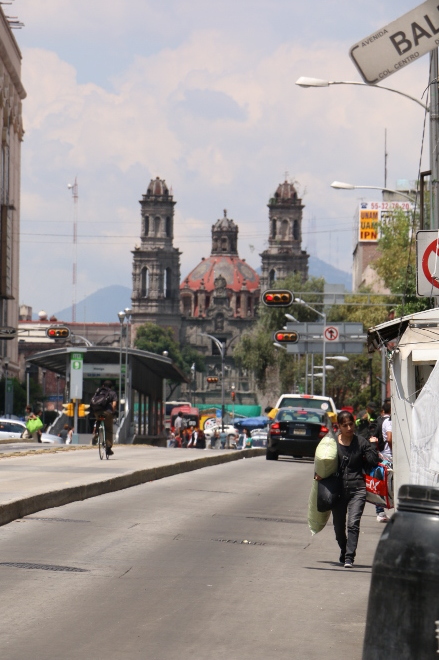 |
| San Hipólito, a colonial church, stands at the north end of Balderas, where it intersects with Avenida Hidalgo and Paseo de la Reforma. |
Bounded by four Metro lines: Pink Line 1 on the south, Blue Line 2 on the north, Green Line 8 on the east and Olive Line 3 on the west, West Centro is very accessible, which makes it good for doing business.
Your first experience of the neighborhood, as you amble through it, is of an architectural hodge-podge, an incoherent batiburrillo, a jumble of buildings from various eras. Structures from the colonial period, adapted to contemporary uses, are enmeshed with newer neighbors from the 19th and 20th centuries.
 |
| Mid-20th century functional |
 |
| Colonial building occupied by lighting stores |
 |
| "California" neo-colonial apartment building |
Time-warp of Centuries
The effect of this temporal-spatial desorden can be rather disorienting. You seem to be in no particular place or time, or in several simultaneously. It is as though you have entered a kind of time-warp that the chilangos, city residents, around you seem either not to have noticed or are not disturbed by.
As elsewhere in the city, daily life goes on, with its predictable actions and rhythms.
 |
| Comida corrida, lunch on the run |
Fortunately, the neighborhood also has another constant urban reference, a tranquil refuge. San Juan Park is a quintessential Mexican plaza, where you can center yourself, collect your mind and try to make some sense of the desorden you are experiencing.
 |
| San Juan Plaza |
At one side of the plaza is the Church of Our Lady of Guadalupe of the Good Tone. Of the Good Tone? Well, it was the gift of a Frenchman, Ernest Pugibet who, in 1879 at age 24, emigrated to Mexico and established a cigarette factory, El Buen Tono, at one side of the plaza. It was very profitable.
Señor Pugibet became one of Mexico's wealthiest businessmen during the Porfiriato, the era of President Porfirio Díaz from 1876 to 1911. During that era many elegant buildings were built in Mexico City, as we shall see in subsequent posts.
 |
| Neoclassic Church of Our Lady of Guadalupe of the Good Tone built 1912 |
 |
| French Second Empire cupola, its copper recently restored |
And in the plaza, another time-warp: monuments to Mexico's first radio announcers. Why here? Because the first radio stations were nearby.
 |
Francisco Rubiales Calvo,
mid-20th century radio and TV announcer,
used the pseudonym Paco Malgesto
|
 |
| Monument to station KEW |
Making Sense of the Batiburrillo
So what to make of this hodgepodge of eras, these fragments of disconnected history, this batiburrillo? We are used to thinking of Mexican history in archeological terms, as a sequence of vertical layers built one atop another, as the Spanish Colonial Historic Center sits atop the remains of Tenochtitlán.
Aha! Suddenly, the pieces fall in place, like the pieces of colored glass forming a pattern in a kaleidoscope: here, around Balderas, the layers aren't just vertical, one atop another, but side by side. It is a horizontal archeological site. The batiburrillo is the jumble of artifacts that would be found in any "dig", but no physical digging is necessary here. All you have to do is walk around and keep your eyes open.
The only "digging" comes afterward, the digging for the histories of the various pieces encountered. And for that, there is the Internet! Fun, relaxed armchair exploration after an intriguing perambulation.
 |
| Rainbow |
 |
| Oaxacan restaurant occupies colonial building |




No comments:
Post a Comment